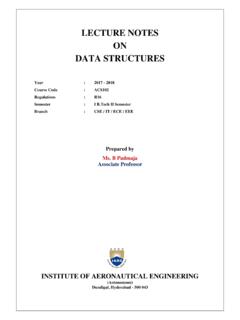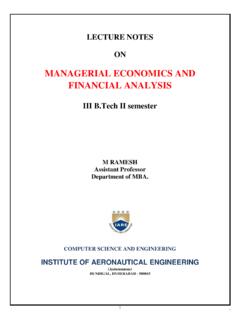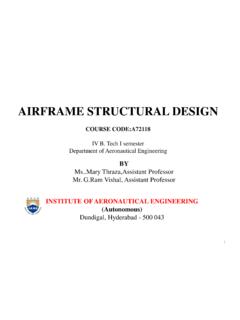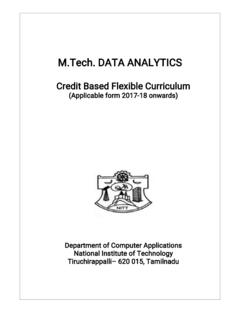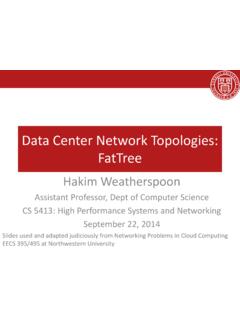Transcription of LECTURE NOTES ON CLOUD COMPUTING
1 1 LECTURE NOTES ON CLOUD COMPUTING IV SEMESTER Prepared by Assistant professor, CSE Assistant professor, CSE Laxmi Assistant professor, CSE B. Tejaswi Assistant professor, CSE COMPUTER SCIENCE AND ENGINEERING INSTITUTE OF AERONAUTICAL ENGINEERING (Autonomous) Dundigal, Hyderabad - 500 043 2 UNIT-I SYSTEM MODELING, CLUSTERING AND VIRTUALIZATION: 1. DISTRIBUTED SYSTEM MODELS AND ENABLING TECHNOLOGIES The Age of internet COMPUTING Billions of people use the internet every day. As a result, supercomputer sites and large data centers must provide high-performance COMPUTING services to huge numbers of internet users concurrently.
2 Because of this high demand, the Linpack benchmark for high-performance COMPUTING (HPC) applications is no longer optimal for measuring system performance. The emergence of COMPUTING clouds instead demands high-throughput COMPUTING (HTC) systems built with parallel and distributed COMPUTING technologies . We have to upgrade data centers using fast servers, storage systems, and high-bandwidth networks. The purpose is to advance network-based COMPUTING and web services with the emerging new technologies. The Platform Evolution Computer technology has gone through five generations of development, with each generation lasting from 10 to 20 years.
3 Successive generations are overlapped in about 10 years. For instance, from 1950 to 1970, a handful of mainframes, including the IBM 360 and CDC 6400, were built to satisfy the demands of large businesses and government organizations. 3 From 1960 to 1980, lower-cost mini- computers such as the DEC PDP 11 and VAX Series became popular among small businesses and on college campuses. From 1970 to 1990, we saw widespread use of personal computers built with VLSI microproces- sors. From 1980 to 2000, massive numbers of portable computers and pervasive devices appeared in both wired and wireless applications.
4 Since 1990, the use of both HPC and HTC systems hidden in. Fig 1. Evolutionary trend toward parallel, distributed, and CLOUD COMPUTING with clusters, MPPs, P2P networks, grids, clouds, web services, and the internet of Things. High-Performance COMPUTING For many years, HPC systems emphasize the raw speed performance. The speed of HPC systems has increased from Gflops in the early 1990s to now Pflops in 2010. This 4 improvement was driven mainly by the demands from scientific, engineering, and manufacturing communities. For example,the Top 500 most powerful computer systems in the world are measured by floating-point speed in Linpack benchmark results.
5 However, the number of supercomputer users is limited to less than 10% of all computer users. Today, the majority of computer users are using desktop computers or large servers when they conduct internet searches and market-driven COMPUTING tasks. High-Throughput COMPUTING The development of market-oriented high-end COMPUTING systems is undergoing a strategic change from an HPC paradigm to an HTC paradigm. This HTC paradigm pays more attention to high-flux COMPUTING . The main application for high-flux COMPUTING is in internet searches and web services by millions or more users simultaneously.
6 The performance goal thus shifts to measure high throughput or the number of tasks completed per unit of time. HTC technology needs to not only improve in terms of batch processing speed, but also address the acute problems of cost, energy savings, security, and reliability at many data and enterprise COMPUTING centers. This book will address both HPC and HTC systems to meet the demands of all computer users. Three New COMPUTING Paradigms A Figure 1. illustrates, with the introduction of SOA, Web services become available. Advances in virtualization make it possible to see the growth of internet clouds as a new COMPUTING paradigm.
7 The maturity of radio-frequency identification (RFID), Global Positioning System (GPS), and sensor technologies has triggered the development of the internet of Things (IoT). 5 COMPUTING Paradigm Distinctions . The high-technology community has argued for many years about the precise definitions of centralized COMPUTING , parallel COMPUTING , distributed COMPUTING , and CLOUD COMPUTING . In general, distributed COMPUTING is the opposite of centralized COMPUTING . The field of parallel COMPUTING overlaps with distributed COMPUTING to a great extent, and CLOUD COMPUTING overlaps with distributed, centralized, and parallel COMPUTING .
8 The following list defines these terms more clearly; their architectural and operational differences are discussed further in subsequent chapters. Centralized COMPUTING . This is a COMPUTING paradigm by which all computer resources are centralized in one physical system. All resources (processors, memory, and storage) are fully shared and tightly coupled within one integrated OS. Many data centers and supercomputers are centralized systems, but they are used in parallel, distributed, and CLOUD COMPUTING applications Parallel COMPUTING In parallel COMPUTING , all processors are either tightly coupled with centralized shared memory or loosely coupled with distributed memory.
9 Some authors refer to this discipline as parallel processing. Interprocessor communication is accomplished through shared memory or via message passing. A computer system capable of parallel COMPUTING is commonly known as a parallel computer . Programs running in a parallel computer are called parallel programs. The process of writing parallel programs is often referred to as parallel programming. Distributed COMPUTING This is a field of computer science/engineering that studies distributed systems. A distributed system consists of multiple autonomous computers, each having its own private memory, communicating through a computer network.
10 Information exchange in a distributed 6 system is accomplished through message passing. A computer program that runs in a distributed system is known as a distributed program. The process of writing distributed programs is referred to as distributed programming. CLOUD COMPUTING An internet CLOUD of resources can be either a centralized or a distributed COMPUTING system. The CLOUD applies parallel or distributed COMPUTING , or both. Clouds can be built with physical or virtualized resources over large data centers that are centralized or distributed.
